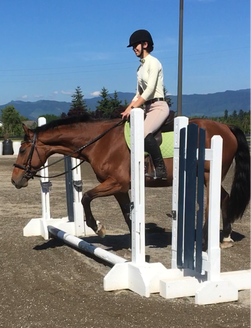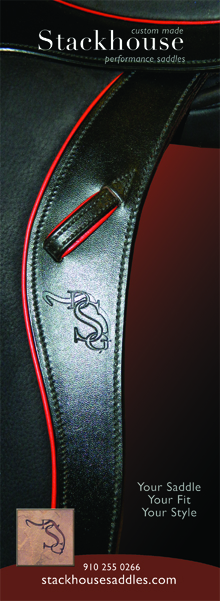Search the Site
Quin's Blog post # 5: A Ground Pole: The Best Jumping Challenge Ever

I’d like to tell you about one of the most challenging exercises I was ever given in a jumping clinic. Before I describe the exercise to you, though, I want to set the scene. I was the hot shot of my barn back then, and I had an extremely scopey and talented mare who would and could jump ANYTHING. I mean, she never stopped. Ever. She never ducked out. Never hesitated. She just went. Every time. I was so proud of this mare. She was a gorgeous mover and a real looker. She’d been very successful at novice and training level in our area, and we were getting ready to move up. I’d been schooling bigger fences, more challenging combinations, and doing the big, “scary” prelim fences out on the XC course. I was SO ready for this clinic, and I knew Bri was too. I couldn’t wait to find out what fun and challenging new heights we’d be able to attain after the clinic that weekend.
There was one other rider in my group, which was the highest level offered that day, and both of us were a little baffled when we rode into the ring and the fences hadn’t been adjusted since the lower groups before us. The clinician greeted us and explained the task: we were to walk over a single pole on the ground.
The other rider and I looked at him, looked at each other, looked at the pole, and looked back at him. Sure that we had misheard, or that it was some kind of trick, we asked him to repeat what he’d said. He clarified the directions: walk over the pole, on a long rein, like you do it every day.
Feeling like this had to be a precursor to something much more fun and exciting, I volunteered to go first. I figured I’d get his silly prelude out of the way so we could get on to the good stuff. I nudged Bri into a walk, circled around, and to make a long, embarrassing story short, we couldn’t do it. Neither could the other rider.
As we approached the pole one by one, each of horses tensed and began to rush, forcing us to shorten our reins and try and hold them to the walk with brute force. When they got to to the pole, each horse leapt or jigged over the pole and wiggled around, unable to halt straight and calm or even walk calmly away afterward. And it happened again, and again, and again. It was a humiliating debacle, and over half the lesson was “wasted” trying to make Bri and the other horse understand that all they needed to do was just walk over the pole.
In the end though, I didn’t regret a second of it because the jumping I got afterward was some of the best Bri had ever done. What I learned that day changed my riding and my training philosophy forever. That silly ground pole led to Bri winning the area championship for me just a few months later, and it has since become one of my favorite diagnostic tools as a trainer and instructor.
Here’s why:
When you ask a horse that already knows how to jump to simply walk over a pole on the ground, how the horse answers the question tells you a surprising amount about their confidence, balance, and understanding of the aids. A horse who truly understands and enjoys his work over fences will stay at the walk with soft contact, maintain a steady tempo and stride length, remain soft over the topline, and walk straight and calmly over the pole without any histrionics -- exactly as he should walk along the track if no pole was there at all.
But … what about the horse who rushes just because they love jumping so much that they simply can’t wait to get to the pole and go over it?
There’s no such thing. It’s a pole on the ground. It’s four inches tall -- about as high as your horse’s coronary band. There’s no need to be that excited, and what we might misread as eager anticipation to jump is exactly the opposite. Horses who get tense and rush over a pole on the ground are demonstrating anxiety, and if that’s how they behave over a ground pole, they’re even more likely to do the same thing over a fence, which isn’t good for anybody because tension adversely affects every aspect of your horse’s jumping performance.
Tension Affects Control. A tense, rushing horse is not responsive to the aids. The steering and brakes are affected when tension is present because the horse becomes either dull to the aids or hyper-sensitive and reactionary. Either way, tension causes a change in the normal communication between horse and rider -- add that to the challenge of negotiating a course and getting over each obstacle, and it’s a recipe for trouble.
Tense Horses Can’t Jump as Well. The topline loses its flexibility when a horse braces in the bridle, inverts, curls, or leans on the bit in order to rush to the fence. As a result, the hind end can’t come under as easily, the spine cannot bascule as effectively, and the horse misses distances, pulls rails, and has a harder time being canny when the take-off doesn’t come out as expected.
Tension Increases the Danger to Both Horse and Rider. In addition to the obvious risks posed by poor distances and poor form over the obstacles, tension causes undue wear and tear on the horse’s body. Backs and leg joints are injured more easily and more frequently when tension is present. Tiny soft tissue strain issues accumulate, and over time, this can can lead to expensive veterinary procedures and can adversely affect the horse’s longevity as a sporthorse.
Tension is often an indicator of an underlying problem, and sometimes a horse that rushes over a pole on the ground is crying out for help. There might be a pain issue that needs to be addressed, or perhaps the rider is tense and conveying that tension to the horse. Maybe the horse lacks confidence and needs to go back to basics and fill in some gaps over smaller obstacles or even on the flat … or it’s possible that there’s been a training error that needs to be corrected to keep both horse and rider safe and happy over fences. Whatever the cause, horses only have so many jumps in them, and I don’t believe in using those up on jumping incorrectly. That’s why I use the question of a pole on the ground with every horse or rider I start over fences.
If they can walk over the pole, we try trotting over it -- maintaining the same rhythm, contact, and calm as I expect on the flat. Then we canter. If the horse can do that, then I build a pile of three poles between a set of standards and run the drill again. If this can be done with calm obedience at all three gaits, THEN we jump, and not before.
How does your horse answer the question of the pole on the ground? Can you walk, trot, and canter over it with the same horse you have for a twenty-meter circle on a flatwork day? Hopefully, the answer is “yes”, but in the event that the challenge takes you by surprise as it did me, rejoice! Now you have a window into your horse’s thinking, and you can start problem-solving, without using up those precious body parts on fence after fence -- and you may be surprised at how many jumping issues evaporate when you and your horse master the art of walking over a pole on the ground.






